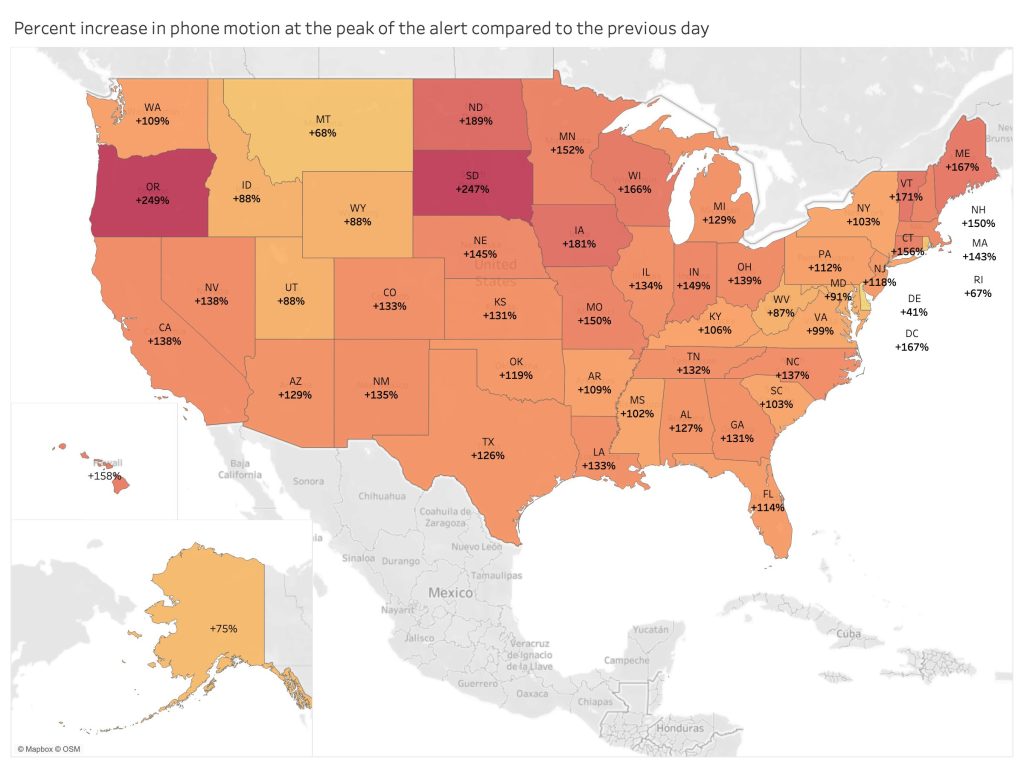National Alert Sends Distracted Driving Skyrocketing

Around 2:20 p.m. EDT on Wednesday, October 4, smartphones blared in the White House briefing room. At the same time at the University of Texas at Austin, phones interrupted a speech from Secretary of State Antony Blinken.
Across the United States last Wednesday, phones buzzed at the same time as the federal government tested the national emergency alert system. FEMA, which conducted the test, estimates that hundreds of millions of people received the alert.
The only way to avoid getting the alert was to turn off your phone, activate airplane mode, or disconnect your phone from the network.
Drivers got the alert as well.
CMT’s data shows that phone motion distraction, when the screen is on and the driver is handling the phone, skyrocketed on Wednesday around 2:20 p.m. CMT analyzed the driving data from over 1 million drivers across the US on Wednesday, October 4, and compared it to the levels of phone motion distraction on Tuesday, October 3.
At 2:18 p.m. on October 4, phone motion distraction was 124% higher than the day before. A minute later, it was 34% higher. By 2:26 p.m., phone motion distraction returned to normal daily levels.
To identify phone motion distraction, CMT processes smartphone sensor data and uses machine learning to interpret the phone’s physical movements. The data from this analysis indicates that drivers received the national alert and interacted with their phones immediately.

The alert impacted distracted driving rates across the country. Even in states that have recently enacted hands-free laws, like Ohio and Michigan, distraction spiked 139% and 129%, respectively. Montana drivers had the lowest level of interaction with the alert, with a 68% increase. Oregon saw the highest jump in distraction with a 249% rise.
In preparing for the national test, FEMA worked to limit creating dangerous situations for millions of people. For people who keep a secret phone for emergencies, FEMA recommended turning off their phones from 2:20 to 2:50 p.m.
CMT’s data shows that the alerts can cause also dangerous situations for millions of drivers. Turning off their phone may not be practical for many drivers who rely on navigation apps.
Do Not Disturb While Driving is a feature that blocks most incoming notifications that activates automatically using the phone’s sensors. To reduce another surge of distracted driving from the next national alert, federal officials should consider a solution that works with the phone’s operating systems. This strategy could delay the alert until the drive is finished, similar to how Do Not Disturb While Driving blocks other notifications, and avoid dangerous distracted driving events.
About Cambridge Mobile Telematics
Cambridge Mobile Telematics (CMT) is the world’s largest telematics service provider. Its mission is to make the world’s roads and drivers safer. The company’s AI-driven platform, DriveWell®, gathers sensor data from millions of IoT devices — including smartphones, proprietary Tags, connected vehicles, dashcams, and third-party devices — and fuses them with contextual data to create a unified view of vehicle and driver behavior. Companies from personal and commercial auto insurance, automotive, rideshare, smart cities, wireless, financial services, and family safety industries use insights from CMT’s platform to power their risk assessment, safety, claims, and driver improvement programs. Headquartered in Cambridge, MA, with offices in Budapest, Chennai, Seattle, Tokyo, and Zagreb, CMT serves millions of people through 110 programs in 25 countries, including 21 of the top 25 US auto insurers. Learn more at CMT.ai.
Media Contact: Lisa-Marie Pascuccio lpascuccio@cmtelematics.com
